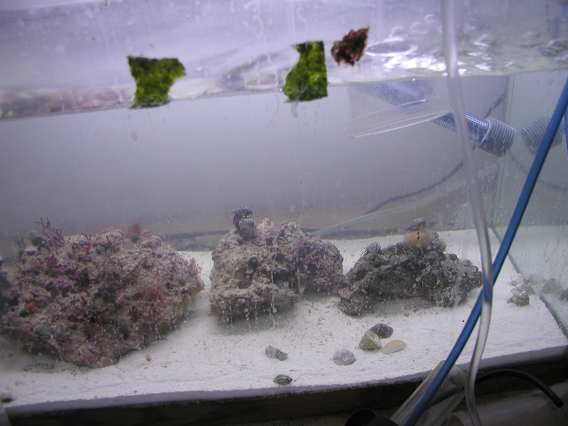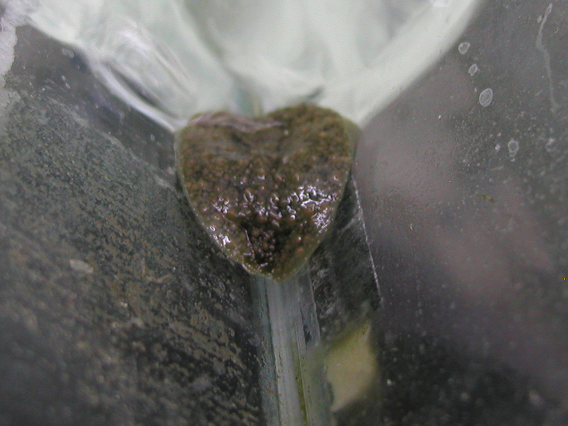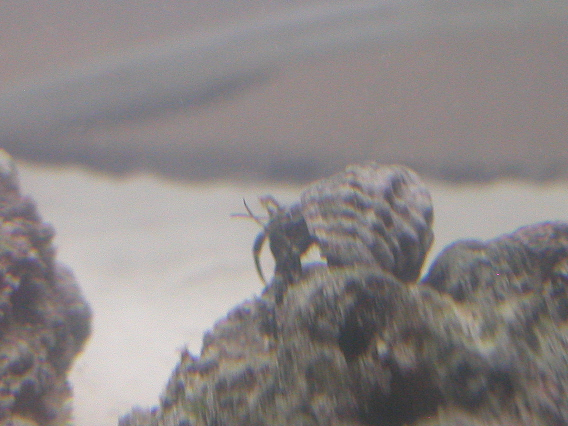Thought I would get this slugarium business rolling finally...
Primary tank goal: house a large Dolabella auricularia sea hare that has proven to be much more toxic than is the norm for the species, wiping out all but one fish and almost all of my sea urchins in two different tanks as it was moved from one to the other. So, the big rules for this tank are: no fish and no sea urchins.
Secondary tank goal: an opportunity to house other normally fish-toxic animals. Sea hares don't live very long, and the one responsible for this tank being set up is already quite large, so it may already be about to enter old age or will do so in probably at most another 6 months. I will be adding other Aplysiids along the way, probably another D. auricularia or two since I am aware of some captive breeding successes with this species.
Tertiary tank goal: coral grow-out? Corals were unharmed by the primary subject for the tank.
Tank: 20gal high (US gallons)
Rock: ~12lbs as 3 pieces of LR
Substrate: ~1-1.5" of dry aragonite, soon to be deepened with a bag of live sand I picked up.
In-tank equipment
- Current: one powerhead (temporary to remove sand silt) with floss-covered intake, a heater (also temporary) and an air line
- Planned: no powerheads (for heat reasons in the summer), heater only in extreme low temps, air-only flow, and air-driven skimmer
Lighting
Current: one T8 bulb in a grow-light sort of fixture
Planned: hopefully a lot better as LEDs or something if I want to have anything to do with that third goal LOL
The tank got thrown together quite fast since I needed the sea hare moved into it. All rock is from cycled tanks so I'm seeing no cycle and some CUC is in already. Although it is invert-only and therefore less demanding on filtration than a tank with fish, I am monitoring daily to see how it handles things with relatively little rock.
I need to clean the glass, but...

The main subject acclimating:

A small slimey friend:

Part of the current CUC:

Current stock:
- 1x Dolabella auricularia
- 1x Dolabelifera...something. I forget right now. It's the one that looks like a flat toad.
- 6x Clibanarius striolatus*
- 2x Calcinus elegans
* The Clibanarius striolatus will NOT be part of the long-term CUC for this tank as they get quite large. After a couple of molts they will be moved. The species is hard to find and they are so small they don't have a safe home anywhere else. As they grow they will get moved with the other C. striolatus I have and only the Calcinus elegans will remain (I may need another couple - they serve as bristleworm control). C. elegans has been peaceful in all instances that I have had it with small Clibanarius species, so although I have introduced risk here by temporarily mixing species (and genera) it is a lower risk than others I have seen. Even so, it's split into the east side and west side hermits. They do not go on the same rocks.
Stock that will get added soon when the sand bed gets a bit better:
- 2x Strombus luhuanus conches
Primary tank goal: house a large Dolabella auricularia sea hare that has proven to be much more toxic than is the norm for the species, wiping out all but one fish and almost all of my sea urchins in two different tanks as it was moved from one to the other. So, the big rules for this tank are: no fish and no sea urchins.
Secondary tank goal: an opportunity to house other normally fish-toxic animals. Sea hares don't live very long, and the one responsible for this tank being set up is already quite large, so it may already be about to enter old age or will do so in probably at most another 6 months. I will be adding other Aplysiids along the way, probably another D. auricularia or two since I am aware of some captive breeding successes with this species.
Tertiary tank goal: coral grow-out? Corals were unharmed by the primary subject for the tank.
Tank: 20gal high (US gallons)
Rock: ~12lbs as 3 pieces of LR
Substrate: ~1-1.5" of dry aragonite, soon to be deepened with a bag of live sand I picked up.
In-tank equipment
- Current: one powerhead (temporary to remove sand silt) with floss-covered intake, a heater (also temporary) and an air line
- Planned: no powerheads (for heat reasons in the summer), heater only in extreme low temps, air-only flow, and air-driven skimmer
Lighting
Current: one T8 bulb in a grow-light sort of fixture
Planned: hopefully a lot better as LEDs or something if I want to have anything to do with that third goal LOL
The tank got thrown together quite fast since I needed the sea hare moved into it. All rock is from cycled tanks so I'm seeing no cycle and some CUC is in already. Although it is invert-only and therefore less demanding on filtration than a tank with fish, I am monitoring daily to see how it handles things with relatively little rock.
I need to clean the glass, but...

The main subject acclimating:

A small slimey friend:

Part of the current CUC:

Current stock:
- 1x Dolabella auricularia
- 1x Dolabelifera...something. I forget right now. It's the one that looks like a flat toad.
- 6x Clibanarius striolatus*
- 2x Calcinus elegans
* The Clibanarius striolatus will NOT be part of the long-term CUC for this tank as they get quite large. After a couple of molts they will be moved. The species is hard to find and they are so small they don't have a safe home anywhere else. As they grow they will get moved with the other C. striolatus I have and only the Calcinus elegans will remain (I may need another couple - they serve as bristleworm control). C. elegans has been peaceful in all instances that I have had it with small Clibanarius species, so although I have introduced risk here by temporarily mixing species (and genera) it is a lower risk than others I have seen. Even so, it's split into the east side and west side hermits. They do not go on the same rocks.
Stock that will get added soon when the sand bed gets a bit better:
- 2x Strombus luhuanus conches





